Search Result
Results for "
Prostaglandin E2 (PGE2)
" in MedChemExpress (MCE) Product Catalog:
2
Biochemical Assay Reagents
2
Isotope-Labeled Compounds
| Cat. No. |
Product Name |
Target |
Research Areas |
Chemical Structure |
-
- HY-101952
-
-
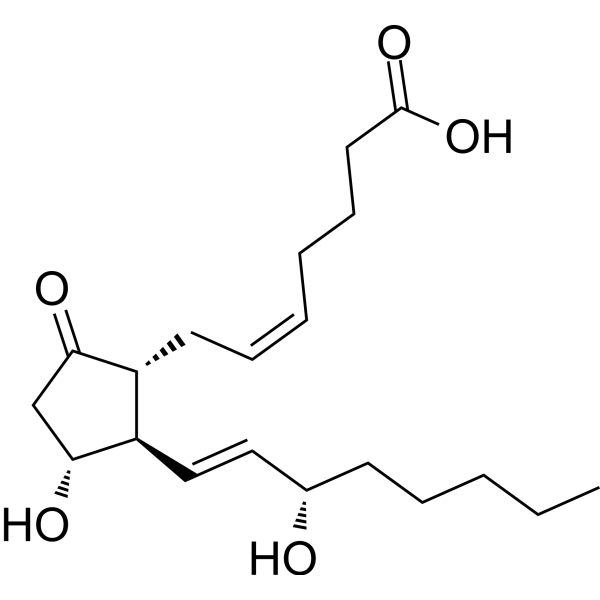
-
- HY-106420
-
|
16,16-dimethyl PGE2
|
Prostaglandin Receptor
|
Inflammation/Immunology
|
|
16,16-Dimethyl prostaglandin E2 (16,16-dimethyl PGE2) is an orally active vertebrate Hematopoietic stem cells (HSCs) homeostasis critical regulator. 16,16-Dimethyl prostaglandin E2 can act through EP2/EP4 and has an interaction with the Wnt pathway .
|
-
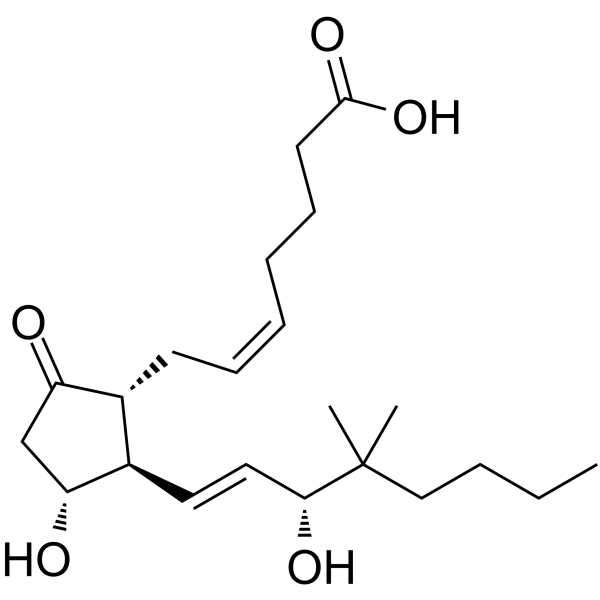
-
- HY-129920
-
|
PGE2 methyl ester
|
Others
|
Metabolic Disease
|
|
Prostaglandin E2 methyl ester (PGE2 methyl ester) is an lipophilic derivative analog of PGE2 (HY-101952). Prostaglandin E2 methyl ester has more central penetration ability than PGE2 .
|
-
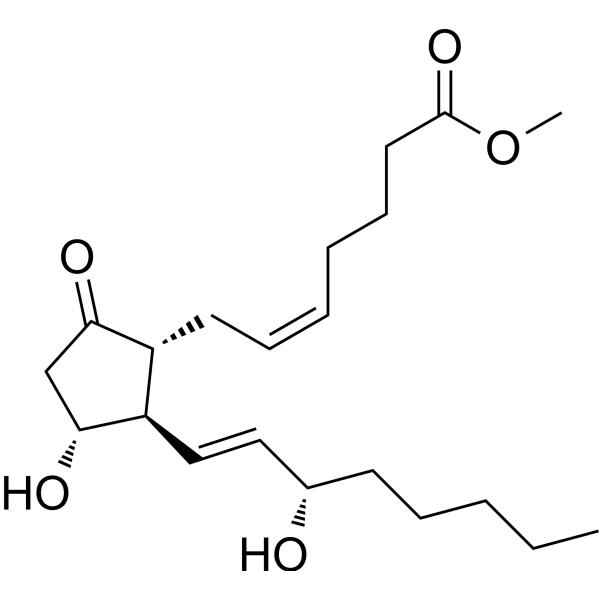
-
- HY-157002
-
|
PGE2 isopropyl ester
|
Others
|
Others
|
|
Prostaglandin E2 isopropyl ester (PGE2 isopropyl ester) is the precursor of PGE2.
|
-
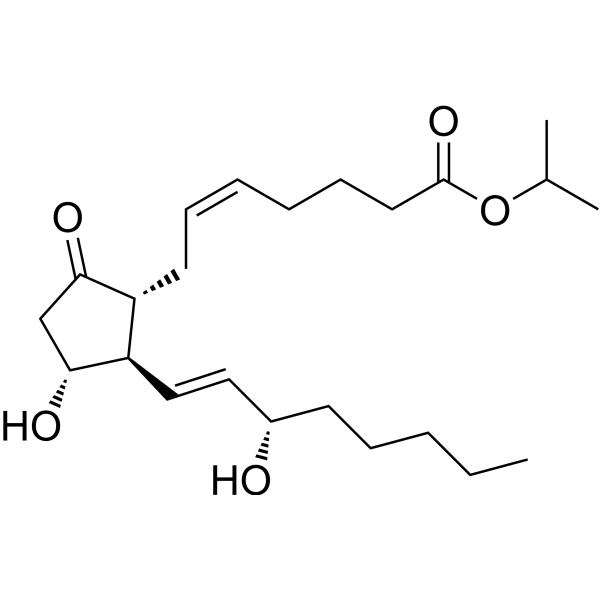
-
- HY-121996
-
|
PGE2 ethanolamide
|
Prostaglandin Receptor
COX
|
Inflammation/Immunology
|
|
Prostaglandin E2 Ethanolamide (PGE2-EA), an analog of PGE2, can be formed enzymatically following COX-2 oxygenation of endocannabinoids. Prostaglandin E2 Ethanolamide (PGE2-EA) could modulate the production of the proinflammatory cytokine TNF-α in human blood and human monocytic cells .
|
-
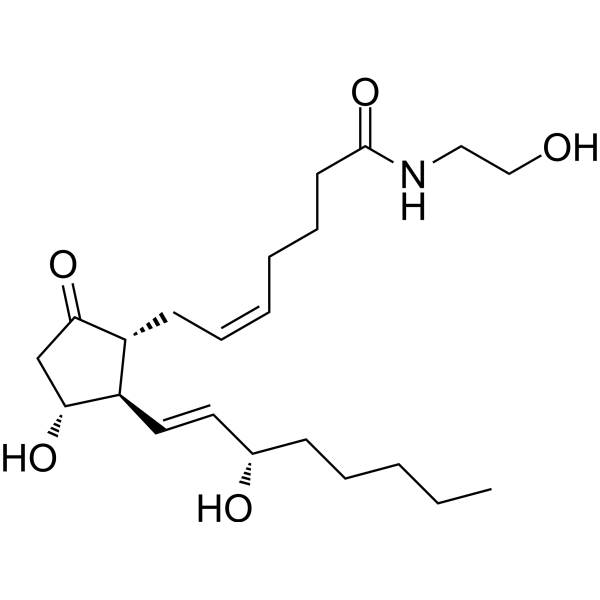
-
- HY-118465
-
|
ent-PGE2
|
Others
|
Endocrinology
|
|
ent-Prostaglandin E2 (ent-PGE2) is an enantiomer of PGE2 (HY-101952). unlike PGE2, ent-PGE2 is a poor substrate for 15-hydroxyprostaglandin dehydrogenase .
|
-
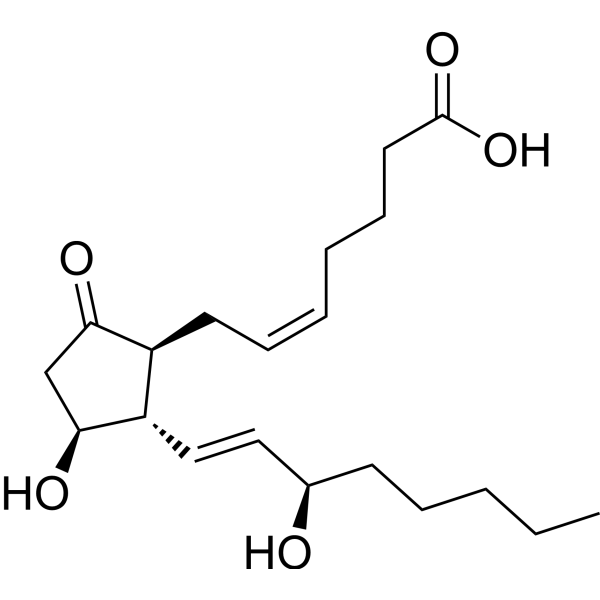
-
- HY-138868
-
|
17-Phenyl trinor PGE2 ethyl amide
|
Prostaglandin Receptor
|
Metabolic Disease
|
|
17-Phenyl trinor prostaglandin E2 ethyl amide (17-Phenyl trinor PGE2 ethyl amide) is a EP1 receptor agonist. 17-Phenyl trinor prostaglandin E2 ethyl amide aggravates renal dysfunction and glomerulosclerosis .
|
-
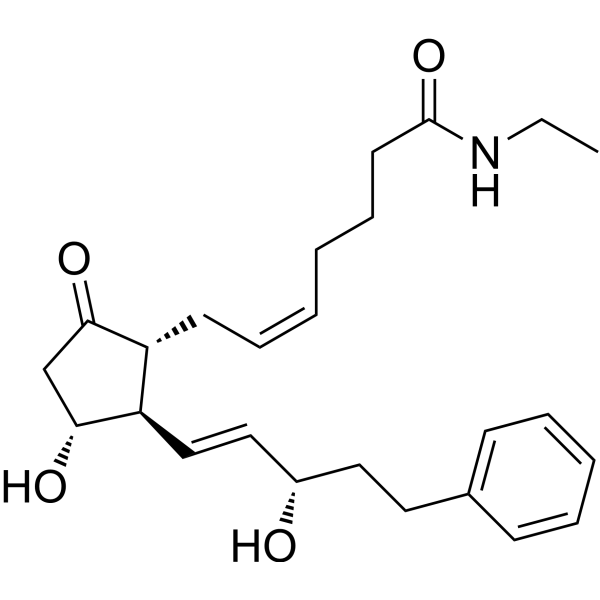
-
- HY-101952R
-
|
PGE2(Standard); Dinoprostone (Standard)
|
Prostaglandin Receptor
Endogenous Metabolite
|
Cardiovascular Disease
Endocrinology
|
|
Prostaglandin E2 (Standard) is the analytical standard of Prostaglandin E2. This product is intended for research and analytical applications. Prostaglandin E2 (PGE2) is a hormone-like substance that participate in a wide range of body functions such as the contraction and relaxation of smooth muscle, the dilation and constriction of blood vessels, control of blood pressure, and modulation of inflammation.
|
-

-
- HY-135023
-
|
5-trans Prostaglandin E2
|
Cytochrome P450
Prostaglandin Receptor
|
Cancer
|
|
5-trans-PGE2 (5-trans Prostaglandin E2) is the active isomer of PGE2 and a potent activator of aromatase. Supplements the process of paracrine signaling between epithelial cells (expressing high levels of PGE2) and surrounding stromal cells (expressing high levels of aromatase). This process is involved in the growth and development of breast cancer .
|
-
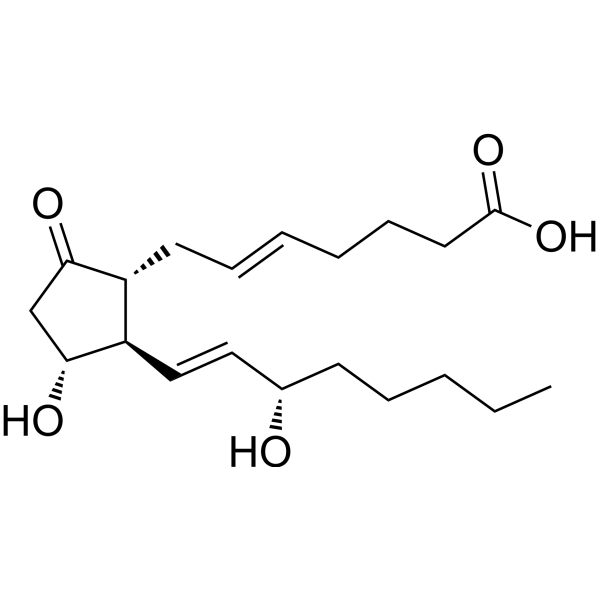
-
- HY-130223
-
|
11β-Dinoprostone; 11β-PGE2
|
Prostaglandin Receptor
|
Endocrinology
|
|
11β-Prostaglandin E2 (11β-Dinoprostone), a Prostanoid derivative, inhibits [ 3H]PGE2 binding to hypothalamic membranes in the rat with a Ki of 53.3 nM .
|
-
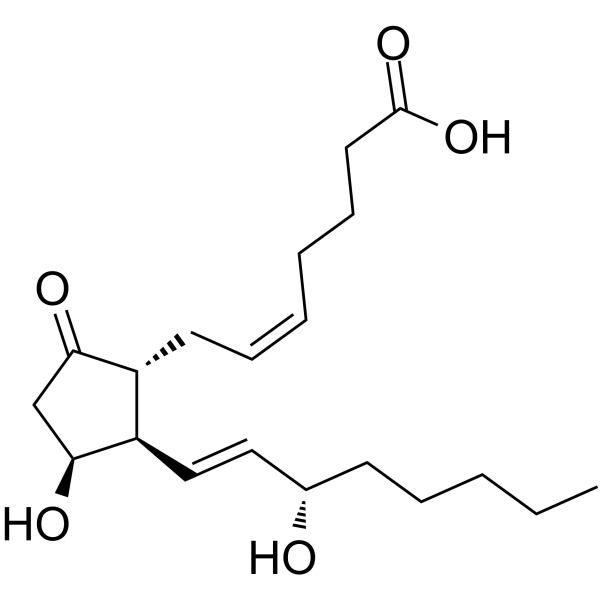
-
- HY-101952S
-
|
PGE2-d4; Dinoprostone-d4
|
Prostaglandin Receptor
Endogenous Metabolite
|
Cardiovascular Disease
Endocrinology
|
|
Prostaglandin E2-d4 is the deuterium labeled Prostaglandin E2. Prostaglandin E2 (PGE2) is a hormone-like substance that participate in a wide range of body functions such as the contraction and relaxation of smooth muscle, the dilation and constriction of blood vessels, control of blood pressure, and modulation of inflammation[1][2].
|
-

-
- HY-101952S1
-
-
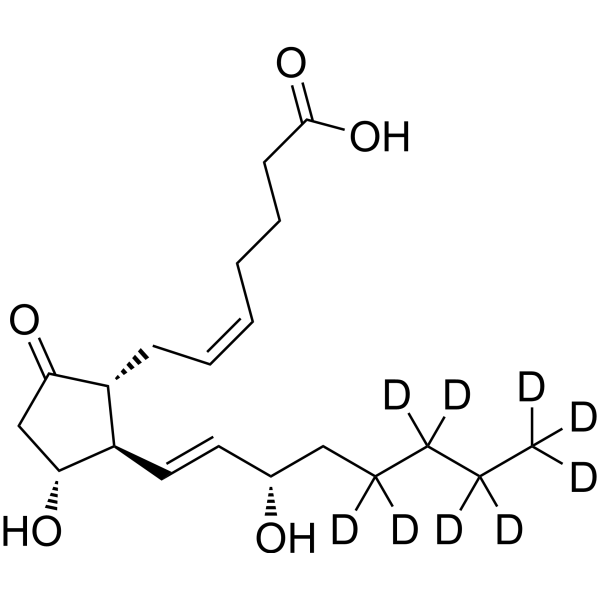
-
- HY-101952G
-
|
PGE2; Dinoprostone
|
Endogenous Metabolite
|
Cardiovascular Disease
Endocrinology
|
|
Prostaglandin E2 (GMP) is Prostaglandin E2 (HY-101952) produced by using GMP guidelines. GMP small molecules work appropriately as an auxiliary reagent for cell therapy manufacture. Prostaglandin E2, an inflammatory mediator, is a endogenous hormone-like substance that participate in a wide range of body functions .
|
-
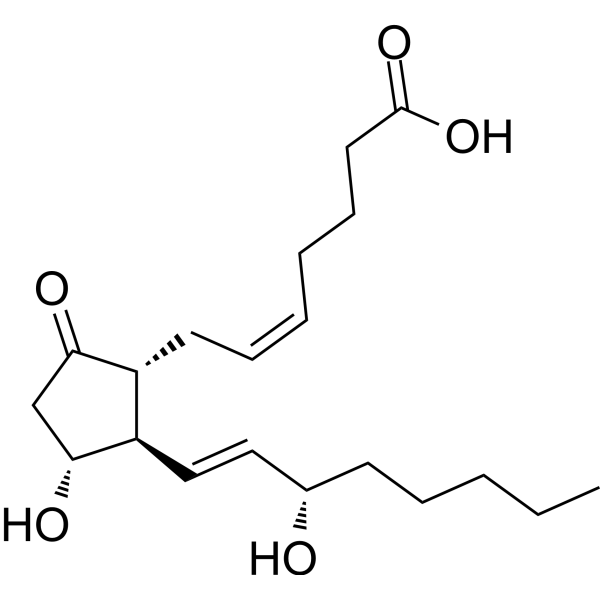
-
- HY-118556
-
|
|
Prostaglandin Receptor
|
Endocrinology
|
|
Prostaglandin E2 serinol amide is a weak inhibitor of the hydrolysis of [3H]2-oleoylglycerol. Prostaglandin E2 serinol amide is non-hydrolyzable to produce PGE2 and thus cannot inhibit leukotriene B4 biosynthesis, superoxide production, migration and antimicrobial peptide release .
|
-
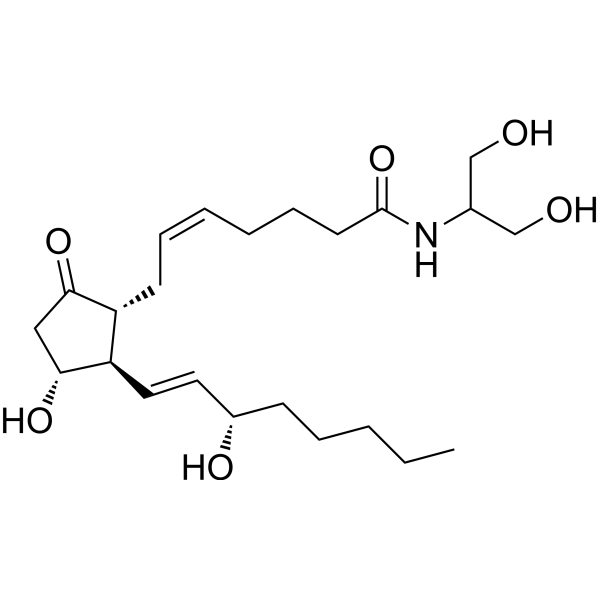
-
- HY-N3380
-
|
|
PGE synthase
Interleukin Related
|
Inflammation/Immunology
|
|
Linderaspirone A is a natural compound that can be isolated from the roots of Lindera aggregate. Linderaspirone A shows significant inhibitory effects on the production of prostaglandin E2 (PGE2),TNF-α, and IL-6 .
|
-
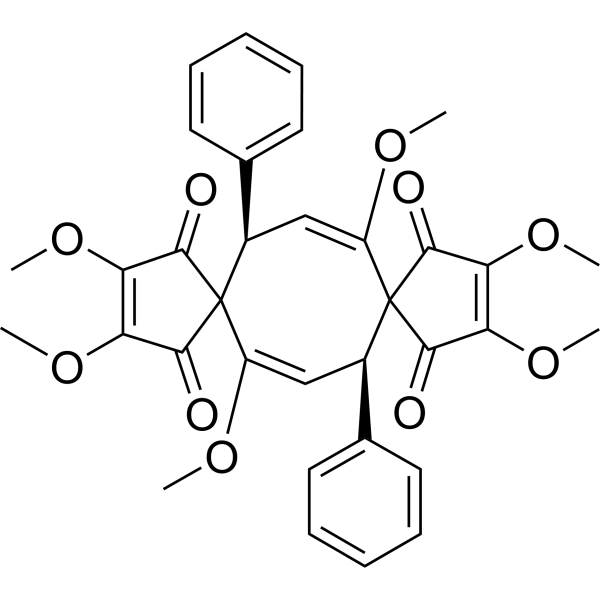
-
- HY-108562
-
-
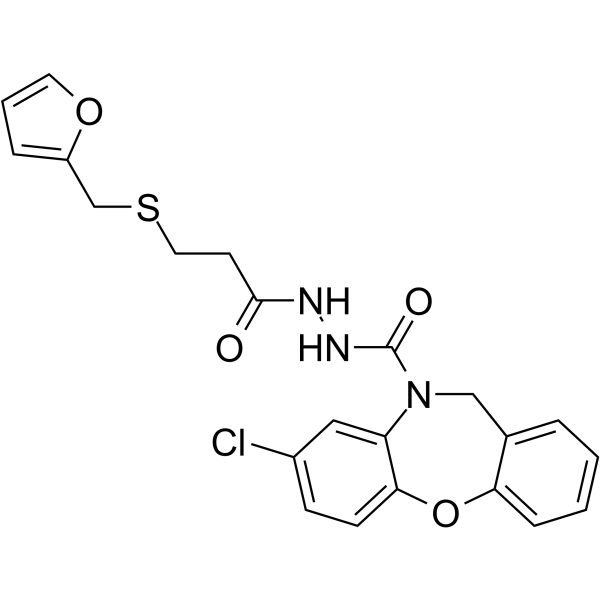
-
- HY-N0223
-
-

-
- HY-116099
-
|
|
Prostaglandin Receptor
|
Inflammation/Immunology
|
|
ER-819762 is an orally active, highly selective prostaglandin E2 (PGE2) EP4 receptor antagonist with an EC50 of 70 nM against human EP4 receptor. ER-819762 can be used for rheumatoid arthritis research .
|
-
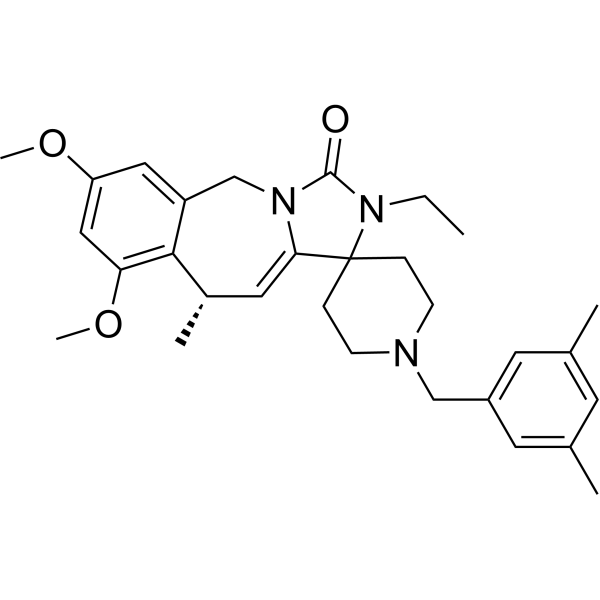
-
- HY-16781
-
|
CJ-023423; RQ-00000007; AAT-007
|
Prostaglandin Receptor
|
Metabolic Disease
Endocrinology
Cancer
|
|
Grapiprant (CJ-023423) is a selective EP4 receptor antagonist whose physiological ligand is prostaglandin E2 (PGE2). Grapiprant displaces [ 3H]-PGE2 (1 nM) binding to dog recombinant EP4 receptor with IC50 value of 35 nM and Ki value of 24 nM. Grapiprant has the potential for osteoarthritic pain and inflammation treatment [3] .
|
-
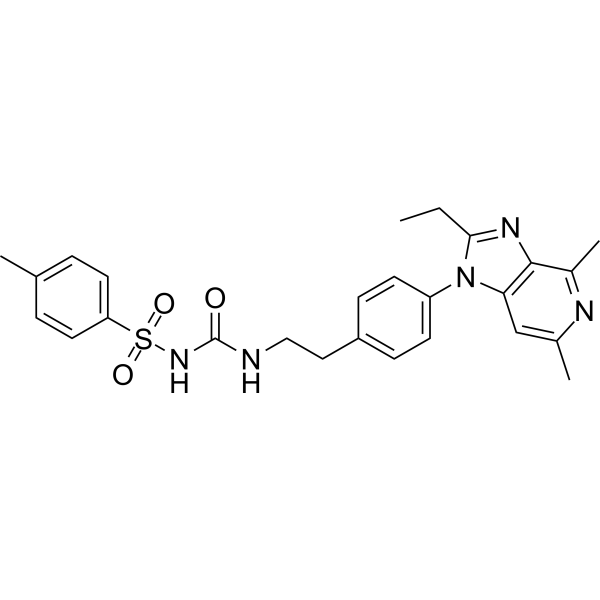
-
- HY-105005
-
|
AAD-2004
|
Others
|
Neurological Disease
|
|
Crisdesalazine (AAD-2004) is an anti-inflammatory agent that simultaneously blocks inflammation mediated by free radicals and prostaglandin E2 (PGE2). Crisdesalazine (AAD-2004) can be used to study neurodegeneration in amyotrophic lateral sclerosis (ALS) and other neurodegenerative diseases .
|
-
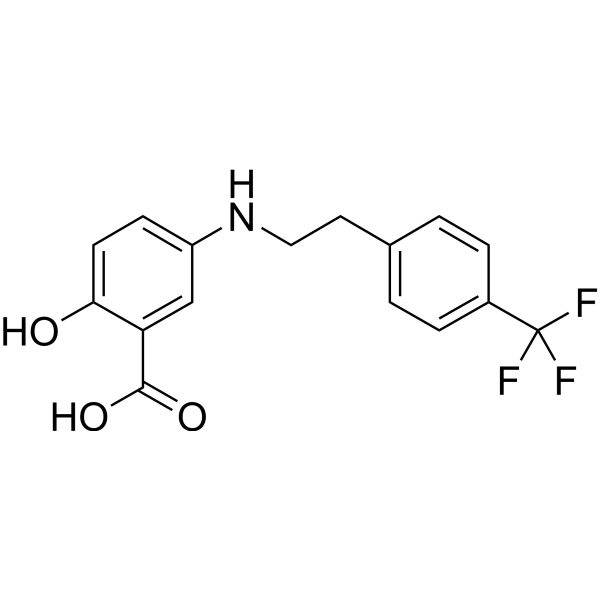
-
- HY-19360
-
|
SHB 286; CP-34089; ZK-57671
|
|
|
|
Sulprostone (SHB 286) is a potent and selective EP3 receptor agonist. Sulprostone (SHB 286) is a prostaglandin E2 (PGE2) analogue and has antiulcer and nonsteroidal abortifacient effects. Sulprostone has potential for the research of pregnancy termination and hemorrhages during delivery .
|
-

-
- HY-136696
-
|
|
Prostaglandin Receptor
|
Metabolic Disease
|
|
11-Deoxy-16,16-dimethyl-PGE2, a Prostaglandin E2 analog, is a EP2 and EP3 receptors agonist. 11-Deoxy-16,16-dimethyl-PGE2 protects proximal renal tubular epithelial cells from potent nephrotoxicity-induced cell damage by exerting anti-oxidative stress .
|
-
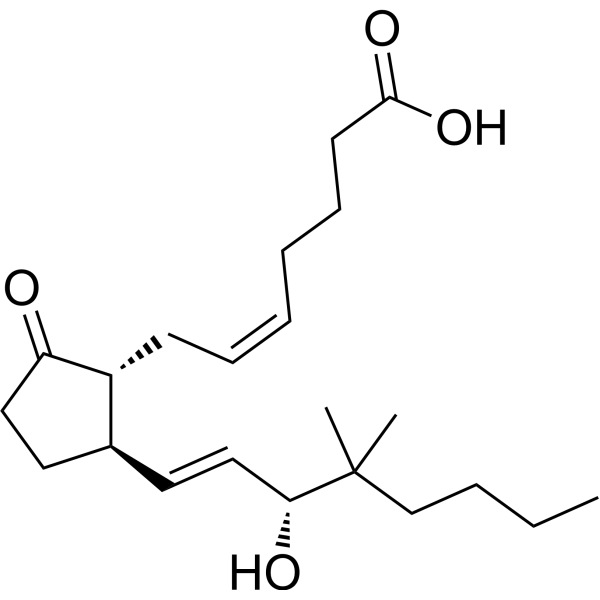
-
- HY-N6966
-
|
|
NF-κB
NO Synthase
COX
PGE synthase
|
Inflammation/Immunology
Cancer
|
|
Ethyl Caffeate is a natural phenolic compound isolated from Bidens pilosa. Ethyl caffeate suppresses NF-κB activation and its downstream inflammatory mediators, inducible nitric oxide synthase (iNOS), cyclooxygenase-2 (COX-2), and prostaglandin E2 (PGE2) in vitro or in mouse skin .
|
-
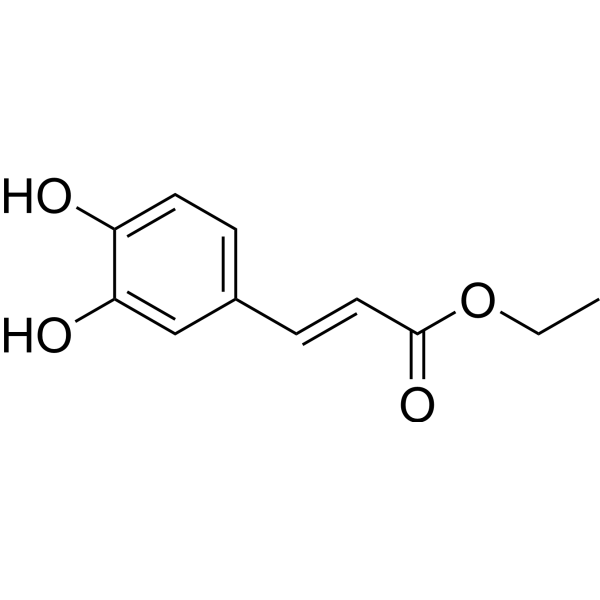
-
- HY-N2106
-
|
|
|
|
|
Dehydroevodiamine is a major bioactive quinazoline alkaloid isolated from Evodiae Fructus, has an antiarrhythmic effect in guinea-pig ventricular myocytes . Dehydroevodiamine inhibits LPS-induced iNOS, COX-2, prostaglandin E2 (PGE2) and nuclear factor-kappa B (NF-κB) expression in murine macrophage cells .
|
-
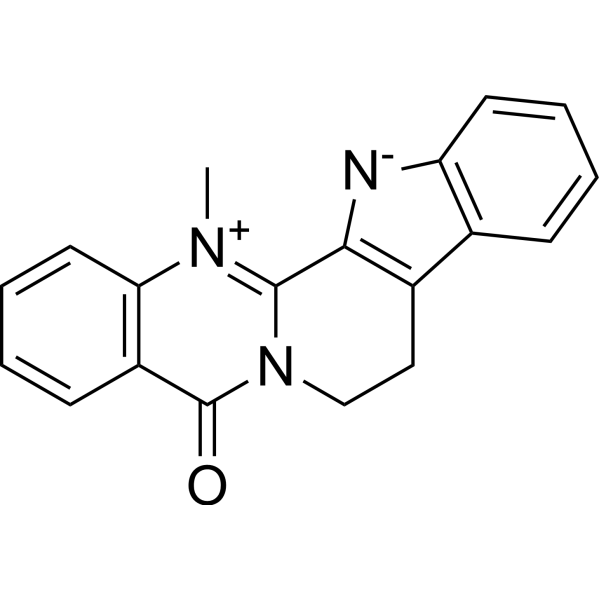
-
- HY-106054
-
|
|
Prostaglandin Receptor
|
Metabolic Disease
Inflammation/Immunology
|
|
Nocloprost, a prostaglandin E2 (PGE2) analog, is an orally active EP1- and EP3-receptor agonist. Nocloprost inhibits evoked [ 3H]ACh release. Nocloprost has gastroprotective and ulcer-healing properties. Nocloprost accelerates the healing of chronic gastric ulcerations and enhances mucosal growth in rats .
|
-
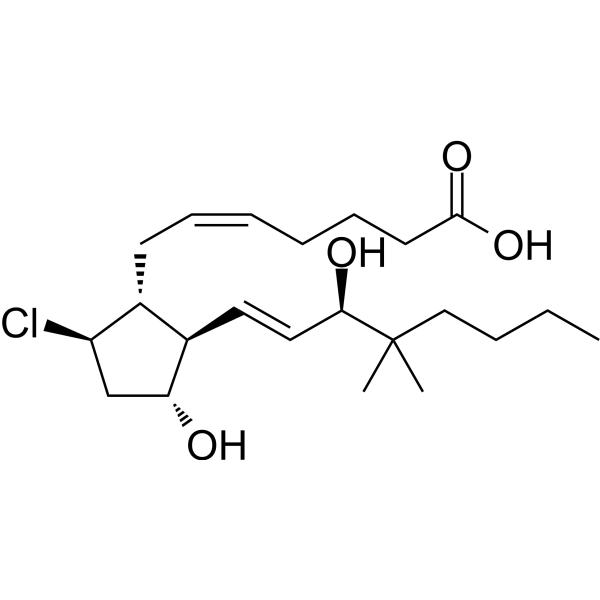
-
- HY-113205
-
|
15-keto-PGE2
|
Endogenous Metabolite
Prostaglandin Receptor
STAT
PPAR
|
Cancer
|
|
15-keto-Prostaglandin E2 is an endogenous metabolite. 15-keto-Prostaglandin E2 inhibits STAT3 activation by binding to its Cys259 residue. 15-keto-Prostaglandin E2 can bind and stabilize EP2 and EP4 receptor. 15-keto-Prostaglandin E2 inhibits breast cancer cell growth and progression. 15-keto-Prostaglandin E2 activates PPAR-γ and promotes fungal growth .
|
-
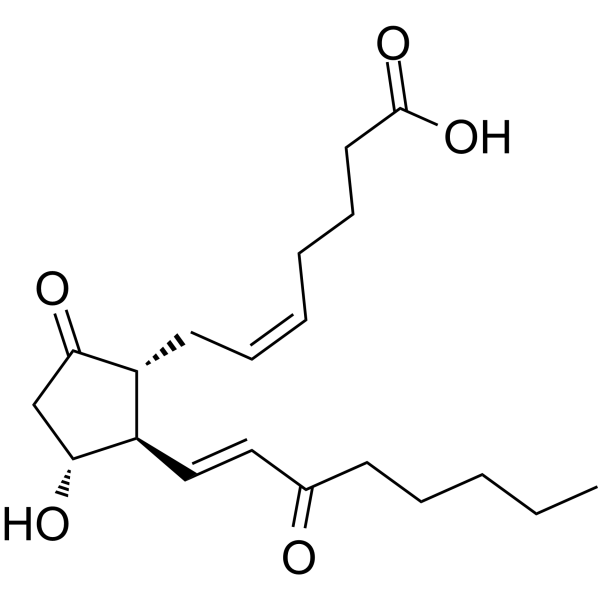
-
- HY-118116
-
|
bicyclo-PGEM; bicyclo-Prostaglandin E2
|
Others
|
Others
|
|
bicyclo-PGE2 (bicyclo-PGEM) is a stable decomposition product of PGE2 and 13, 14-dihydro-15-ketone PGE2 .
|
-
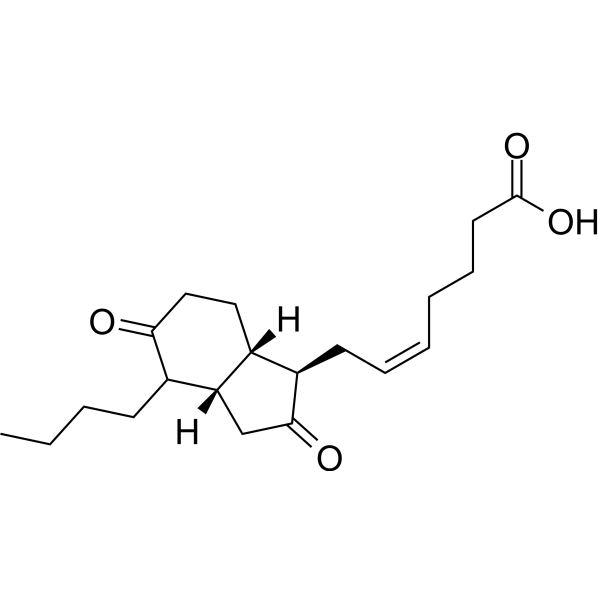
-
- HY-N4237
-
|
|
Prostaglandin Receptor
Potassium Channel
|
Inflammation/Immunology
|
|
Saikogenin D is isolated from Bupleurum chinense, has anti-inflammatory effects. Saikogenin D activates epoxygenases that converts arachidonic acid to epoxyeicosanoids and dihydroxyeicosatrienoic acids, and the metabolites secondarily inhibit prostaglandin E2 (PGE2) production. Saikogenin D results in an elevation of [Ca 2+]i due to Ca 2+ release from intracellular stores .
|
-
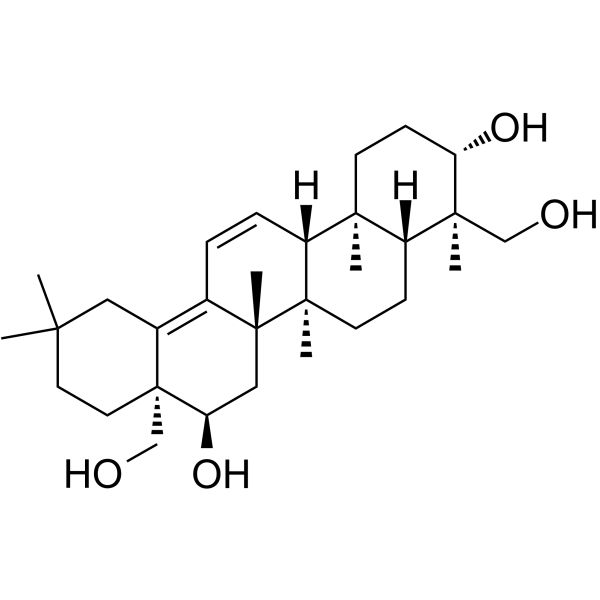
-
- HY-N0074
-
|
|
COX
|
Inflammation/Immunology
|
|
Byakangelicol, isolated from Angelica dahurica, inhibits interleukin-1beta (IL-1beta) -induced prostaglandin E2 (PGE2) release in A549 cells mediated by suppression of cyclooxygenase-2 (COX-2) expression and the activity of COX-2 enzyme. Byakangelicol has therapeutic potential as an anti-inflammatory agent on airway inflammation .
|
-
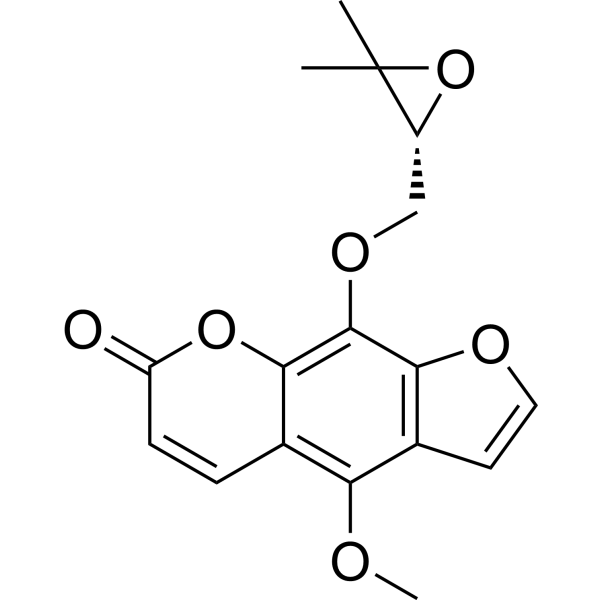
-
- HY-N6966A
-
|
|
Others
|
Inflammation/Immunology
|
|
Ethyl trans-caffeate is the trans form of Ethyl Caffeate (HY-N6966). Ethyl Caffeate is a natural phenolic compound isolated from Bidens pilosa. Ethyl caffeate suppresses NF-κB activation and its downstream inflammatory mediators, inducible nitric oxide synthase (iNOS), cyclooxygenase-2 (COX-2), and prostaglandin E2 (PGE2) in vitro or in mouse skin .
|
-
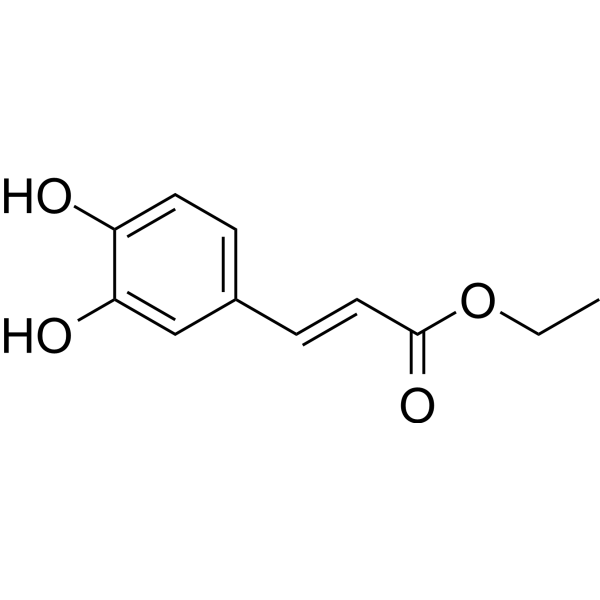
-
- HY-111140
-
|
|
PGE synthase
Lipoxygenase
|
Inflammation/Immunology
|
|
YS121 is a dual inhibitor of microsomal prostaglandin E2 synthase-1 (mPGES-1; IC50=3.4 μM) and 5-lipoxygenase (5-LOX; IC50=6.5 μM). YS121 dose- dependently reduces PGE2 production with EC50=12 μM in IL-1β-stimulated A549 cells .
|
-
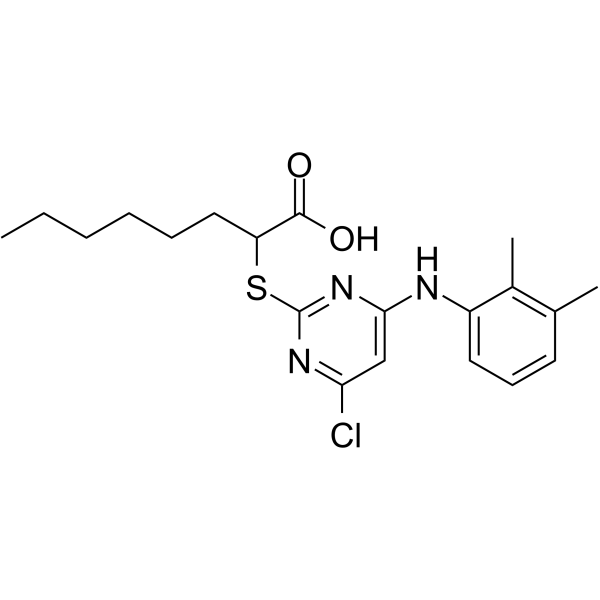
-
- HY-N8936
-
|
|
Others
|
Inflammation/Immunology
|
|
Narchinol B (Compound 4) is a sesquiter penoid
compound. Narchinol B has anti-inflammatory effects. Narchinol B works by
inhibiting proinflammatory mediators, including prostaglandin E2 (PGE2),
inducible nitric oxide synthase (iNOS), and cyclooxygenase-2 (COX-2) proteins,
as well as proinflammatory cytokines, such as interleukin-1b, IL-6, and tumor
necrosis factor-α (TNF-α). Narchinol B significantly inhibits LPS-induced
overproduction of NO in BV2 cells (IC50=2.43 μM)
.
|
-
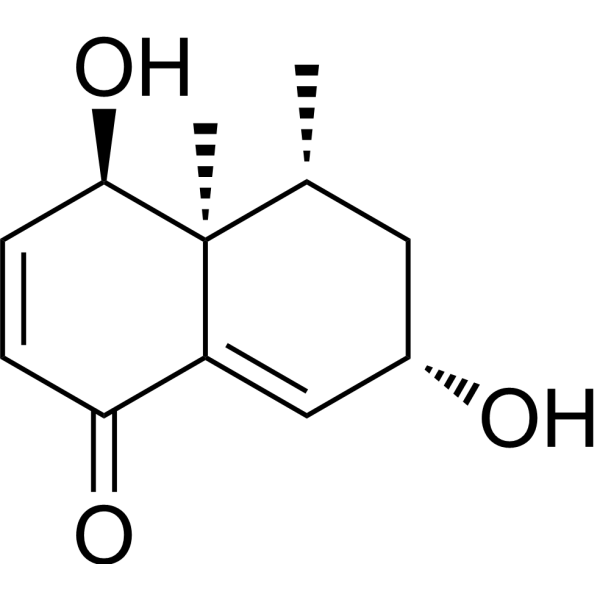
-
- HY-157494
-
-
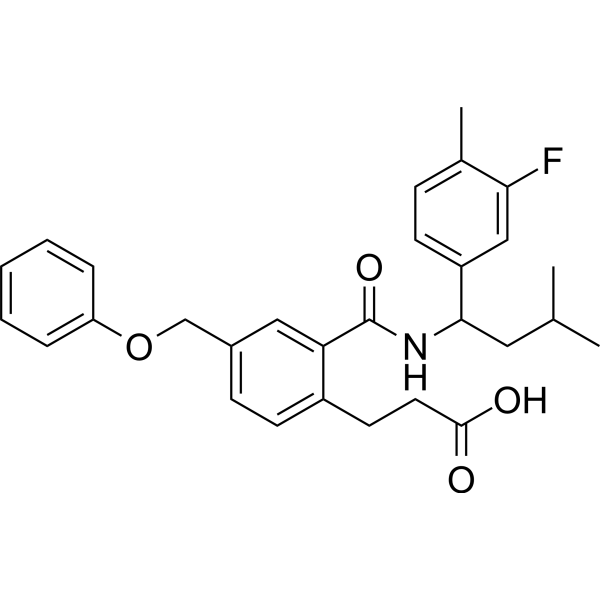
-
- HY-120973
-
|
|
Biochemical Assay Reagents
|
Others
|
|
(R)-Butaprost (free acid). Butaprost is a structural analog of prostaglandin E2 (PGE2) with good selectivity for the EP2 receptor subtype. Butaprost is frequently used pharmacologically to define the expression profile of EP receptors in various human and animal tissues and cells. Gardiner caused serious confusion about the structure of butaprost in 1986 when he reported that the epimer of butaprost showing this selective activity was the C-16 (R)-epimer ( See reference 2 and notes). To increase the binding affinity of (R)-butaprost to prostaglandin receptors, we removed the methyl ester of (R)-butaprost and recreated the native C-1 carboxylic acid. Prostaglandin free acids typically bind their cognate receptors with 10 to 100-fold higher affinity than the corresponding ester derivatives. The pharmacology of (R)-butaprost has not been carefully studied, but it is generally considered to be the less active C-16 epimer. (Note: In the 1986 Gardiner paper in the British Journal of Pharmacology, butaprost appears on page 46 under the designation TR 4979. The structure drawn is incorrect because the authors use and refer to the more active C - The 16 epimer, which is actually 16(S). The structure on page 46 shows the structure as 16(R). It was not until the late 1990s that careful studies in the United States and Japan correctly determined the actual structure of C-16 The type is 16(S) in a compound called butaprost.)
|
-

| Cat. No. |
Product Name |
Type |
-
- HY-101952G
-
|
PGE2 (GMP); Dinoprostone (GMP)
|
Fluorescent Dye
|
|
Prostaglandin E2 (GMP) is Prostaglandin E2 (HY-101952) produced by using GMP guidelines. GMP small molecules work appropriately as an auxiliary reagent for cell therapy manufacture. Prostaglandin E2, an inflammatory mediator, is a endogenous hormone-like substance that participate in a wide range of body functions .
|
| Cat. No. |
Product Name |
Type |
-
- HY-101952G
-
|
PGE2 (GMP); Dinoprostone (GMP)
|
Biochemical Assay Reagents
|
|
Prostaglandin E2 (GMP) is Prostaglandin E2 (HY-101952) produced by using GMP guidelines. GMP small molecules work appropriately as an auxiliary reagent for cell therapy manufacture. Prostaglandin E2, an inflammatory mediator, is a endogenous hormone-like substance that participate in a wide range of body functions .
|
-
- HY-120973
-
|
|
Biochemical Assay Reagents
|
|
(R)-Butaprost (free acid). Butaprost is a structural analog of prostaglandin E2 (PGE2) with good selectivity for the EP2 receptor subtype. Butaprost is frequently used pharmacologically to define the expression profile of EP receptors in various human and animal tissues and cells. Gardiner caused serious confusion about the structure of butaprost in 1986 when he reported that the epimer of butaprost showing this selective activity was the C-16 (R)-epimer ( See reference 2 and notes). To increase the binding affinity of (R)-butaprost to prostaglandin receptors, we removed the methyl ester of (R)-butaprost and recreated the native C-1 carboxylic acid. Prostaglandin free acids typically bind their cognate receptors with 10 to 100-fold higher affinity than the corresponding ester derivatives. The pharmacology of (R)-butaprost has not been carefully studied, but it is generally considered to be the less active C-16 epimer. (Note: In the 1986 Gardiner paper in the British Journal of Pharmacology, butaprost appears on page 46 under the designation TR 4979. The structure drawn is incorrect because the authors use and refer to the more active C - The 16 epimer, which is actually 16(S). The structure on page 46 shows the structure as 16(R). It was not until the late 1990s that careful studies in the United States and Japan correctly determined the actual structure of C-16 The type is 16(S) in a compound called butaprost.)
|
| Cat. No. |
Product Name |
Category |
Target |
Chemical Structure |
| Cat. No. |
Product Name |
Chemical Structure |
-
- HY-101952S
-
|
|
|
Prostaglandin E2-d4 is the deuterium labeled Prostaglandin E2. Prostaglandin E2 (PGE2) is a hormone-like substance that participate in a wide range of body functions such as the contraction and relaxation of smooth muscle, the dilation and constriction of blood vessels, control of blood pressure, and modulation of inflammation[1][2].
|
-

-
- HY-101952S1
-
|
|
|
Prostaglandin E2-d9 is the deuterium labeled Prostaglandin E2. Prostaglandin E2 (PGE2) is a hormone-like substance that participate in a wide range of body functions such as the contraction and relaxation of smooth muscle, the dilation and constriction of blood vessels, control of blood pressure, and modulation of inflammation[1][2].
|
-

| Cat. No. |
Product Name |
Application |
Reactivity |
-
- HY-P83597
-
|
EP2; PGE2 receptor EP2 subtype; Prostaglandin E receptor 2 subtype EP2 53kDa; Prostaglandin E2 receptor EP2 subtype; Prostanoid EP2 receptor; Ptger2
|
WB, IHC-P, ICC/IF, FC
|
Human, Mouse, Rat, Cow |
Your information is safe with us. * Required Fields.
Inquiry Information
- Product Name:
- Cat. No.:
- Quantity:
- MCE Japan Authorized Agent:










































